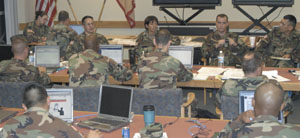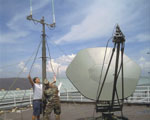 |
Col. Christine Gayagas, USA, chief of staff for the 13th Corps Support Command (COSCOM), conducts mission planning with the Joint Logistics Command in support of hurricane relief operations at New Orleans’ Louis Armstrong International Airport. The command was tasked with setting up emergency communications networks in Louisiana in the wake of the two hurricanes that
struck the Gulf Coast. |
Dropping into a domestic disaster area does not always analogize with an overseas combat deployment, but it comes close.
A Texas-based U.S. Army unit drew on Iraq experience to provide hurricane relief in its neighboring state. The group dropped into New Orleans, Louisiana, set up vital communications, and then redeployed to another location and expanded its network without missing a byte.
Having recently returned from Iraq, the group was able to draw on experience in establishing mobile communications in an infrastructure-poor environment. Similarly, its disaster relief experiences in the Gulf Coast of the United States provided new insights into mobile connectivity that can be applied when it re-deploys to Iraq.
The 13th Corps Support Command (COSCOM), Fort Hood, Texas, was ordered into Louisiana a few days after Hurricane Katrina devastated the port city. Maj. Kenneth A. Patterson, USA, G-6, communications chief, 13th COSCOM, explains that its commander, Brig. Gen. Michael Terry, USA, ordered the command to begin planning for a New Orleans deployment the day after the hurricane hit, on a Monday. The command received the official call to deploy from the Federal Emergency Management Agency (FEMA) the following Saturday, and Gen. Terry flew out on Sunday to meet with Lt. Gen. Russell Honoré, USA, commander of Joint Task Force Katrina, in New Orleans. The command deployed to Louis Armstrong International Airport in New Orleans on Wednesday, nine days after the storm hit.
On arrival, COSCOM was labeled the Joint Logistics Command. It had components from the U.S. Air Force, Navy, Marine Corps and the Reserve all under its responsibility. Liaison officers from each organization were embedded in the command’s headquarters. The major relates that the command originally set up a tactical operations center (TOC)—in an airport terminal—consisting of just one table equipped with an Inmarsat hookup, one data terminal, one unclassified computer and one unclassified telephone.
The command’s mission began to grow quickly, the major notes. The command received support from a TSC-85 satellite communications van belonging to the 56th Signal Battalion, Fort Gordon, Georgia. The van was set up outside the airport terminal, and it helped the command provide 50 data lines and 30 telephone lines. That constituted all of the command’s connectivity out of the airport.
COSCOM brought many engineering elements with it to New Orleans. These included a contingent from the 62nd Engineer Battalion, which worked on debris clearance. Other elements that were coordinated from the headquarters include preventive medicine experts and mortuary personnel. Maj. Patterson explains that all of these missions were being coordinated with the civilian New Orleans political leadership as well as with Gen. Honoré’s staff.
Opening the airport to air traffic was a major goal in resurrecting New Orleans, so the command’s TOC was moved to a location about a half-mile outside of the terminal building. Along with the TSC-85 van, the command added a very small aperture satellite (VSAT) system that it brought from Fort Hood. The command incorporated a Promina 400 into the TSC-85 to blend the TSC-85 and VSAT bandwidth. With this configuration, the command could provide 2 megabits downlink through the VSAT and 3 megabits through the TSC-85 for a total of 5 megabits downlink. Headquarters had unclassified Internet access and secret Internet protocol router network (SIPRNET) connectivity through the TSC-85 van.
“The communications that we were able to provide off of the TSC-85 van and the VSAT were really flawless,” the major relates.
Maj. Patterson reports that the headquarters was able to conduct videoconferencing with Gen. Honoré’s staff over the SIPRNET. This videoconferencing largely was unclassified, but it was run through the SIPRNET because of the paucity of bandwidth. That SIPRNET link did not experience heavy classified traffic.
Ten days in the airport parking lot saw continuous improvements in the communications suite, the major points out. Personnel rewired the TOC for greater efficiencies in the tactical environment.
When Hurricane Rita threatened the Gulf Coast, the command’s personnel moved back inside the airport terminal. This sheltering move led to a fortuitous encounter, Maj. Patterson relates. Command officials met with an official from Ericsson Systems Incorporated who introduced them to the company’s QuickLink system. The company brought it while working with the Army’s Communications-Electronics Research Development and Engineering Center based at Fort Monmouth, New Jersey.
This system comprises a 9-meter mast mounting an omnidirectional antenna, and it provides up to an 18-mile-radius footprint for an internal cellular telephone network. It also can be interfaced with a satellite transmission media to create a command and control network that can operate in either mode. Maj. Patterson likens it to a Mobile Subscriber Equipment remote access unit, and it can provide as many as 400 telephones. He reports that the command’s technicians set it up in about 45 minutes using only a digital photograph as an instruction manual.
“It comes with its own power generation, so you really have a stand-alone command and control network right there in an easily transportable system,” the major explains.
 |
| Technicians set up a portable cell tower to provide service in dead cell zones. While cellular service proved very useful in the days after Hurricane Katrina hit New Orleans, some cell towers failed from flooding or power outages. |
Another fortuitous encounter involved infrastructure. Technicians testing their network test meters discovered that airport wall-based dataports were live. Command officials obtained permission from the airport’s administrator to run their own network using one of his Internet protocol addresses. Command personnel were pleased to discover that this fast network enabled them to hit the Internet in 19 milliseconds, so they hooked up a 48-port switch and ran their entire TOC over that network.
“Everyone was pretty ecstatic over that feed, because you don’t really find that very often in a tactical scenario,” Maj. Patterson explains.
After four more days at the airport, half of the COSCOM staff was assigned to Lafayette, Louisiana, to support response efforts for Hurricane Rita. They performed the same functions as in New Orleans, and their communications largely relied on VSAT connectivity.
There they were based at an Army Reserve facility, and ironically this caused some compatibility problems. Maj. Patterson relates that the facility’s stand-alone network included “some goofy security stuff” that would have required the COSCOM personnel to obtain new individual user accounts. “It became too painful to just use their network, so we set up the VSAT again and used it to provide the network,” he explains. The Lafayette network ran 50 unclassified data lines off of the VSAT and 25 telephone lines that ran off of the Army Reserve Center.
“With the VSAT, we were able to jump forward and have an already-established network,” he explains. “At our original [airport] location, there was a network in place and our staff could basically just unplug their computers, get in the vehicles and move to the new location. The only down time for our staff was the time it took them to transition from one location to another.”
Maj. Patterson relates that his unit had returned from Iraq in January of this year, and many of the people in the G-6 shop had been considering retirement. Between June and August, his group saw almost a 100-percent transition of personnel. These new people did not always have a full understanding of the Corps Support Command’s mission, and they did not grasp its communications capabilities and requirements fully. The Katrina operation allowed its personnel to learn a new set of lessons for future deployments, both domestically and overseas.
The command encountered some significant differences between establishing communications in Iraq and Louisiana. Supporting a U.S.-based operation, even in the wake of a disaster, was easier from the standpoint of existing infrastructure. The major reports that no real infrastructure remained in Iraq. The only reliable communications and power infrastructure came from whatever U.S. forces put in place.
In Louisiana, the command was able to use the existing infrastructure significantly, he continues. Both the airport and the Army Reserve Center were able to contribute to telephone or data linkage. The command brought its own cellular telephones that worked in New Orleans and Lafayette, although it did notice some dead zones. Some temporary towers set up by cellular providers to serve cells where the existing primary towers failed during the storm were damaged by flooding or died when their backup power ran out.
But, not knowing whether cellular service would work effectively, the command purchased 25 Iridium satellite telephones just before deployment to Louisiana. They provided immediate mobile telephone coverage in many areas where no telephony—not even cellular—was available. Maj. Patterson indicates that when the command redeploys to Iraq, those satellite telephones will go with it to serve as emergency mobile communications units.
“One of our lessons learned was that you can’t have enough mobile communications,” he declares.
Another lesson learned was that everybody wanted a cell or satellite telephone. Because not everybody can have one, the command G-3 led an operational validation of the command’s true communications needs. This helped establish which personnel really needed a satellite telephone, and assignments were made accordingly.
The usefulness of the VSAT links is spurring the command to buy two more VSAT systems. The way the command was able to pick up, jump and re-establish the network rapidly is driving that purchase, the major explains.
While the command has its eye on its future deployment to Iraq, it did apply some lessons learned from its past deployment there. One of those was the ability to keep moving, the major offers. In Iraq, U.S. forces are in a war zone 24 hours a day, seven days a week. In Louisiana, troops needed to work long hours—22 hours a day in the early phases—to establish, maintain and exploit their communications links. “Every soldier with a combat patch on understands, and has the experience to know, that you put in the work ahead of time, up front and early; and it pays dividends in the end,” the major states.
Another key to COSCOM’s success in Louisiana was mission analysis that the group performed even before deployment, Maj. Patterson allows. In his view, this made the difference in the command’s ability to step into a mission and to change direction when needed.
“We saw units out there that did not do firm detailed mission analysis, and they didn’t know what they were doing,” he maintains. “They didn’t have a plan for how to react to these ever-changing missions. We brought 25 switches and 15 routers, which are much more than are needed just to set up a TOC. We planned through every scenario that we could come across, and then we resourced ourselves to accomplish the mission.”
Web Resource
13th Corps Support Command (COSCOM), Fort Hood: www.hood.army.mil/13coscom






Comments